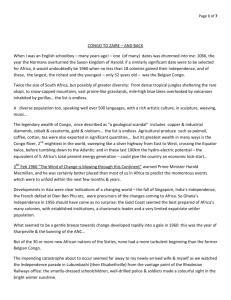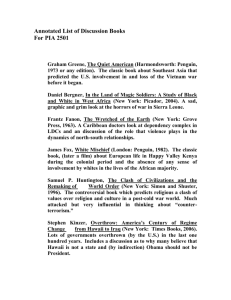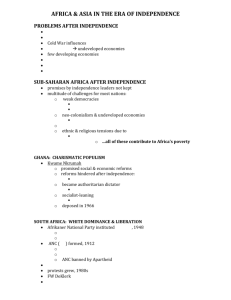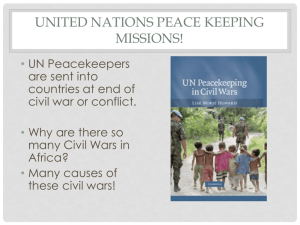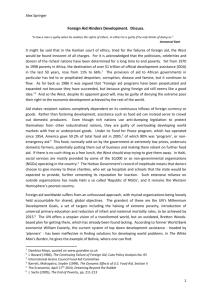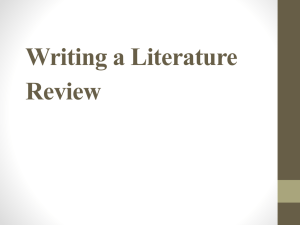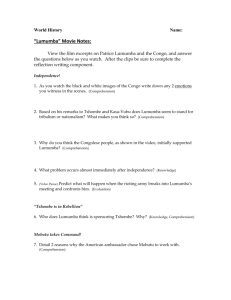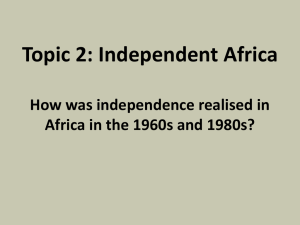Definition of neopatrimonialism, structures and processes
advertisement
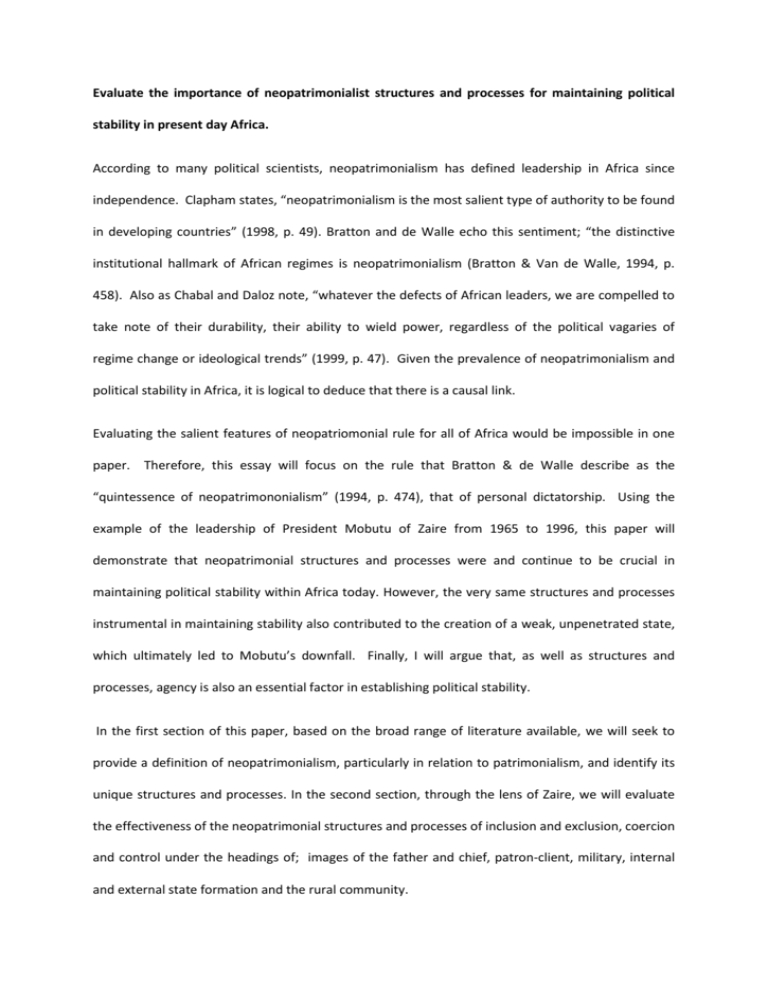
Evaluate the importance of neopatrimonialist structures and processes for maintaining political stability in present day Africa. According to many political scientists, neopatrimonialism has defined leadership in Africa since independence. Clapham states, “neopatrimonialism is the most salient type of authority to be found in developing countries” (1998, p. 49). Bratton and de Walle echo this sentiment; “the distinctive institutional hallmark of African regimes is neopatrimonialism (Bratton & Van de Walle, 1994, p. 458). Also as Chabal and Daloz note, “whatever the defects of African leaders, we are compelled to take note of their durability, their ability to wield power, regardless of the political vagaries of regime change or ideological trends” (1999, p. 47). Given the prevalence of neopatrimonialism and political stability in Africa, it is logical to deduce that there is a causal link. Evaluating the salient features of neopatriomonial rule for all of Africa would be impossible in one paper. Therefore, this essay will focus on the rule that Bratton & de Walle describe as the “quintessence of neopatrimononialism” (1994, p. 474), that of personal dictatorship. Using the example of the leadership of President Mobutu of Zaire from 1965 to 1996, this paper will demonstrate that neopatrimonial structures and processes were and continue to be crucial in maintaining political stability within Africa today. However, the very same structures and processes instrumental in maintaining stability also contributed to the creation of a weak, unpenetrated state, which ultimately led to Mobutu’s downfall. Finally, I will argue that, as well as structures and processes, agency is also an essential factor in establishing political stability. In the first section of this paper, based on the broad range of literature available, we will seek to provide a definition of neopatrimonialism, particularly in relation to patrimonialism, and identify its unique structures and processes. In the second section, through the lens of Zaire, we will evaluate the effectiveness of the neopatrimonial structures and processes of inclusion and exclusion, coercion and control under the headings of; images of the father and chief, patron-client, military, internal and external state formation and the rural community. Definition of neopatrimonialism, structures and processes Political scientists use ‘neopatrimonialism’ as a generic term to describe a wide variety of regime types and behaviours and often fail to delineate it from patrimonialism. In this section, I will narrow the focus to give a clear definition of neopatrimonialism as opposed to patrimonialism, and will highlight the key structures and processes which are unique to it. Firstly to understand neopatrimonalism we need to understand its root of patrimonialism. Writers broadly agree that neopatrimonialism derived from Max Weber’s 1922 theory of “patrimonial authority” as one form of “traditional authority” (de Grassi, 2008). Erdmann & Engel base their discussions on neopatrimonialism on Weber’s definition of patrimonial authority, describing patrimonialism as, “obedience not to enacted rules but a person who occupies a position of authority by tradition or who has been chosen for it by the traditional master” (2007, p. 97). Clapham echoes this but adds “but one who is firmly anchored in a social and political order” (1998, p. 47). I would agree with the Weber’s emphasis on the “inherent legitimacy” found in patrimonial rule (Pitcher, Moran, & Johnston, 2009, p. 126). The image formed in this type of system is one of reciprocity, with parties being highly aware of their mutual dependence and who have the means of holding each other accountable. Unlike the patrimonial regime, according to Bratton & de Walle, the legal framework, rather than the community, now endows legitimacy to the leader, “neopatrimonialism is a form of organisation where relationships of a broadly patrimonial type pervade a political and administrative system which is formally constructed on rational-legal lines. Officials hold positions in bureaucratic organisations with powers which are formally defined, but exercise these powers as a form not of public service but of private property” (1994, p. 458). Although then closely linked, neopatrimonialism diverges from patrimonialism firstly in that legitimacy is not endowed by the community but rather by the legal position. Secondly, the presence of a legal framework creates a public and private sphere which in a patrimonial system does not exist. Finally, even though there is this distinction between public and private sphere, individuals carry out their roles as if there were none. It is through this intermingling of the public and private sphere that we can identify the key structures and processes. Neopatrimonialism in its structure and processes (in the form of personal dictatorship) is characterised both through inclusion and exclusion. Included within the inner circle of President Mobutu’s power structure were those from his ethnic background, rivals who he chose to keep close, certain ranks within military and the international community. Those who were excluded comprised of elites, the wider military personnel and particularly the rural community. Those groups, included and excluded, provided counteracting forces that held the status quo for 35 years in Mobutu’s Zaire. Secondly, these structures were held together within a legal framework through processes of coercion and control, rather than consensus. Control was established through a centralised structure, giving President Mobutu executive powers over the constitution and all institutions, critical if he was to in maintain his position. However, given the sheer size of the country and the need to “broadcast power” (Herbst, 2000) over a vast distance, coercion through the informal clientpatron network was also necessary. In the second section, we will describe and evaluate the processes of inclusion and exclusion, coercion and control at providing political stability. Finally, when considering the definition of neopatrimonialism, its structures and processes, we must not forget the importance of agency. Lindberg highlights, “States are made up of actors of different kinds, filling the state with a particular content” (2001, p. 181). Structures and processes are critical when considering political stability, however, we cannot ignore the individuals who “fill the state” at any given time and form it. Let us now move onto evaluating the key structures and processes of inclusion and exclusion. Politics of inclusion and exclusion 1. Language of the father and chief The first process by which President Mobutu tried to establish his leadership credentials and his right to control was through his use of language and imagery of the father and chief. In President Mobutu’s own words, “Nowhere in this continent have there been two chiefs in one village, a majority chief and an opposition chief. Dating back to ancestral times there has only been one chief...In Africa we follow an ancestral policy in which, when a problem arises, we rally around the leader and work out a solution. Zaire is a shining example of this policy in action. For this reason, we have become the most stable country in Africa” (Pitcher, Moran, & Johnston, 2009, p. 128). Instrumental to this, Schatzberg highlights how skilfully Mobutu controlled the media and constantly used it as a medium to convey the image he wished his people to internalize; “Father of the Nation, his constant worry has been to assure each daughter and each son of this country the means to nourish themselves, clothe themselves, maintain their health and educate their children” (2001, p. 34). Mobutu exploited the language of pre colonial days, of kinship and of the village to establish his legitimacy and his right to control. Chabal states “this patrimonial quality, rather than the abuse of power, is often key to the longevity of politicians” (2009, p. 52). It is difficult to evaluate importance of language, imagery and the control of the media had in maintaining political stability; however I believe it played a role and through it I believe that President Mobutu actually became to consider himself as the embodiment of Zaire. His use of tribal language, which evoked the precolonial era, was a way of coercing the wider population into remaining loyal to their leader, who on a nationalized stage was now their kin. Chabal and Daloz point out that it was perfectly natural within that culture for seniority and experience to be respected, “cultural explanations of longevity of political elites with their emphasis on the importance of experience and respect for the more aged, do probably make some sense of what is happening” (1999, p. 45) It was the language of inclusion and patronage, an attempt to make the whole country feel connected to him, which in the beginning of his rule may have worked but by the end they were hollow words. 2. Client-patron structures and processes Secondly the processes of inclusion and exclusion within President Mobutu’s client-patron structures were key in maintaining political stability. Clapham suggests the following definition of client-patron links, “[client-patron links are] a relationship of exchange in which a superior provides security for an inferior, and the client in turn provides support for the patron” (1998, p. 55). The form of ‘security’ can vary but can include monetary rewards, positions of power, land or property rights and legal protection. As with patrimonial rule, there is reciprocity, but patron-client relations are based on coercion and control rather than the natural heritage of gift giving and respect as would be experienced in a patrimonial society. The client-patron structure has many echoes of Mancur Olsen’s description of “stationary bandits” “A stationary bandit will...reap the maximum harvest in taxes-and his subjects will get the largest gain from his encompassing interests in the productivity of his domain” (Olson, 2000, p. 129). As long as the inner circle continued to benefit from the clientpatron relationships they were content for President Mobutu to retain power. One process Mobutu used to manage his client-patron networks was to keep them fluid. Leslie states “by frequently rotating government posts, Mobutu manages to maintain uncertainty and vulnerability...He plays the role of big chief...bestowing favours on his subjects based on personal discretion” (Acemoglu, Robinson, & Verdier, 2004). In the same article; “client holders have been constantly reminded of the precariousness of tenure by frequency of office rotation, which simultaneously fuels the hopes of those Zairians anxiously waiting just outside the portals of power” (Acemoglu, Robinson, & Verdier, 2004). They give the example of Nguza Karl i Bond who started as an opponent to Mobutu in the 1960s. “In the 1970s he was brought into the Mobutu camp and at one point became the foreign minister. In 1977 he was accused of treason and he was in exile. By 1985 he was back in favour and became Ambassador to the United States” (Acemoglu, Robinson, & Verdier, 2004, p. 170). Some would argue that considering the post independence context, clientelism was the only way that political stability could be obtain. As Mazrui states, “the African president come from one tribe in the state of multiple tribes. This is the source of what has been termed as “the crisis of legitimacy” in Africa today; those who claim to speak and act for the whole country are still very tribally identifiable” (2004, p. 36) As “Leaders like Mobutu had to compensate for their low or weak initial legitimacy by relying on neopatrimonial strategies” (Pitcher, Moran, & Johnston, 2009, p. 134). In the beginning this strategy worked well for Mobutu and created a certain sense of solidarity within the client network where Mobutu was viewed, as Fanon outlines as “the chairman of the board of impatient profiteers” (Kabemba, 2006, p. 103). However there are weaknesses in this approach. Firstly it is a system which is highly dependent on the availability of resources and if they decline then the likelihood of instability increases. As Snyder states, “It appears that opposition groups emerge not necessarily because they seek political change, but rather because they are disgruntled at not having their share of the pie and see obtaining power as their means of acquiring wealth” (1992, p. 384). We see this very clearly in the 1990s post cold war when Mobutu’s capacity to fund his client networks declined. Prior to this the IMF and the World Bank turned a blind eye to the very obvious plundering of the public purse. According to Reno; “Creditor patience with Mobutu seemed almost limitless during the Cold War. From 1976 to 1990, IMF officials devised fourteen stabilization programs for Zaire. Between 1975 and 1985, continual gentle treatment at Paris Club debt renegotiations led to the rescheduling of $3.5 billion of Zaire’s $7.5 billion external debt...These resources underwrote Mobutu’s patron client network, giving him control over the distribution of resources to loyal associates” (1998, p. 152). Post cold war the IMF and World Bank changed the tone of the negotiations; “In 1991, the IMF announced that Zaire was behind on $81.7 million in payments to the organisation and would receive no new loans. Three years later, the IMF expelled Zaire.” (Reno, 1998, p. 153). We will return to the impact of international support later in this paper, but at this juncture the focus is on the fragility of elite bargains and patron-client networks, when the funding disappears, instability can occur. Secondly, having a system of fluid elite bargains has worked remarkably well for President Mobutu. However, eventually this system conspired to create enemies and an atmosphere of mistrust. When the Rwandan troops arrived in Kinshasa elites were silent as they watched his exit. 3. Military structures and processes One of the biggest threats to political stability within neopatrimonial regimes is from the military. According to Collier “Since Independence, successful African coups have been running at a rate of around 2 a year” (2010, p. 142). Clearly control of the military is critical in establishing political stability. To do this President Mobutu used a number of processes. First of all he created an atmosphere of mistrust and disunity. Snyder writes of Mobutu’s mastery in “neutralizing the threat of a military coup by maintaining close personal control over the armed forces, encouraging rivalries among officer factions, and purging officers deemed untrustworthy” (1992, p. 393). Secondly he ensured that there was a high percentage within the military from his own ethnic region and his own family; “Towards the end of his regime, 46% of the officer corps were from Equateur” (Acemoglu, Robinson, & Verdier, 2004, p. 169). Leading many of the key battalions were his own relatives, Bates notes, “...a civil guard commanded by his brother in law, Kpama Baramoto, a Special Research and Surveillance brigade commanded by General Blaise Bolozi, also related to the President by marriage as well as a Special Presidential Division...commanded by General Nzimbi Ngabale, also a “close relative” (2008, p. 46). He estimated that by surrounding himself with his own ethnic group and relatives his safety and security would be guaranteed. Thirdly he allowed elite units to benefit from “clandestine trade” (Reno, 1998, p. 159). This is illustrated in the example of the Guarde Civile, who were under the command of General Kpama Baramoto, also a close associate of Mobutu, who in the early nineties, expanded the illegal trade of gold and diamond mine operations (Reno, 1998, p. 159). However, how workable was this as a long term strategy? By focusing on factions within the military, he excluded many ranks which led to a breakdown in unity and command, which was ultimately a factor in his downfall. Keen points out “In Zaire, Mobutu maintained a privileged paramilitary forces (often from his own Ngbandi ethnic group), while the army was left in such a neglected state – with corrupt officers appropriating soldiers pay and supplies – that extortion by the military became rife and Laurent Kabila’s rebels were able to advance easily to take the capital in 1997” (2008, p. 23). Indeed many of the senior military went onto to make private deals with multinationals, “exploiting ties with outsiders on their own” (Reno, 1998) which led to the breakdown of the state centred patronage systems into something resembling a state within a state structure. So we see that ultimately the army was on every level, apart from the very elite, decimated, fragmented, unfocused on state protection, completely focused on personal gain and unable to withstand any form of military opposition. 4. External state formation - structures and processes Particularly during the Cold War, external forces in the shape of the US played a vital role in propping up Mobutu’s Zaire. It was clear, following the removal of Patrice Lumumba (due to his communist affiliations and the increasing alignment to the Soviet Union) that the US would do everything within its power to maintain Mobutu in power. The state was seen as a critical buffer against the expansion of Soviet Union’s influence in Sub Saharan Africa. As Bates points out, “In the midst of the Cold War, foreign observers had averted their gaze from Mobutu’s depredations, largely because of his support in fighting communism in Southern Africa” (Bates, 2008, p. 56). As we have previously seen, during this time Mobutu was particularly adept at extracting resources from his patrons despite continually failing to comply with contractual obligations. According to Synder, it was the case of the “tail wagging the dog” (1992, p. 394) as Mobutu skilfully courted international leaders on the international stage. Foreign assistance was not only financial but also military; “Moroccan troops (assisted in 1978 by French and Belgian troops) came to Mobutu’s aid when the Zairian Armed Forces (FAZ) proved incapable of repelling incursions of a mere 1,500 to 2,000 meagrely equipped mercenaries from Angola into the Shaba region of Zaire” (Snyder, 1992, p. 394). How effective is this process where states are reinforced more “externally” by the international community and conglomerates than “internally” by institutions, constitution and civil society (Leander, 2004)? According to Bates “Following the fall of the Soviet Union, the hands of those pushing for political reform in Zaire were no longer stayed by those seeking political services. To receive further financial aid, Mobutu – like other tyrants – had to reform” (2008, p. 116). In the end, it was the International community that had supported him for so long proved to be his downfall. The international community sided with Rwanda when their forces invaded in 1996 as at it suited their political end game of seeing Mobutu removed from power. That said, out of all of the structures and processes within neopatrimonial rule, I believe that the external support that Mobutu received and was able to manipulate as a ‘client’, was the most important factor in keeping Mobutu in power for 35 years. It was primarily this network of international actors in the US, IMF, World Bank and international commercial interests that funded his client-patron network. 5. Rural communities – politics of exclusion Weak internal formation was most apparent in Mobutu’s relationship with the rural community. Mobutu deliberately developed a neopatrimonial structure that excluded not only certain elites at certain times, but more importantly a rural population with whom he had no desire to build any level of accountability. To illustrate Mobutu’s either disdain, disinterest or deliberately disenfranchisement of the wider community, we read in Reno; “The dramatic decline of the formal sector-agricultural production for export followed Mobutu’s disinterest in cultivating support among small agricultural producers...in exchange for revenue and legitimacy” (1998, p. 153). It is possible that as well as being excluded by Mobutu, the rural populations in reaction also drew back themselves, as they had little need of the formal state. Goran Hyden describes the “smallness of peasantry is a source of power” (1980, p. 9) in Tanzania but parallels can be made with Zaire. His argument is that while the land was available for subsistence farming, rural communities could proceed with their lives in relative peace. In Zaire, even Provincial government’s arm was short as it focused on urban centres where taxation was possible (as transaction costs were low compared to inaccessible and dispersed population in rural communities). As Bratton discusses “Political elites wish to extend the authority of the state over scattered populations, most of whom live in rural areas; on the other hand, peasants remain determined to preserve a realm of authority within which to make decisions about their own lives” (1994, p. 231). There was also a tendency to concentrate power in the capital city. As Zolberg states, “Colonisation led to developed capitals but underdeveloped relationship with rural population...Although their ambition was often to extend tentacles throughout society, they were creatures with a relatively large head in the capital and fairly rudimentary limbs” (Zolberg, 1966, pp. 34-35). The image then is of a strong neopatrimonial centre which is weak on the periphery, but this weakness also can work to maintain political stability as it will present little threat to the centre. Something which compounded this disconnect from the central state was the deliberate exclusion of any tax base. According to Di John, “The process of tax collection is one of the most powerful lenses in political economy to assess the distribution of power and the legitimacy of the state and of powerful interest groups in civil society” (2010, p. 2) and Schumpter himself wrote “Taxes not only helped create the state; they helped form it” (DiJohn, 2010, p. 2). The lack of any meaningful tax base meant a lack of accountability of President Mobutu to the people he should have been protecting. In Mobutu, there are parallels of Robert Bate’s book “When Things Fall Apart” where he describes in a fable how “predation is the default position for leaders who can see that they have little to gain from acting as protector or guardian” (2008, p. 20). On the one hand, Mobutu lacked any motivation to develop institutions or a tax base that would create accountability between the state and the wider population, as ultimately this could destabilise his rule. On the other hand the peasant community, untouched by the state, effectively lived their lives independently. It is clear that the exclusion of the rural community within the neopatrimonial structure combined with a failure to develop the rural economy, meant that Mobutu did not face any strong challenges of collective action from the masses. However, ultimately when his power was threatened by external forces he had little support from this community. In the words of Lindberg, “a state which penetrates in the long run has greater freedom to generate conditions favourable to its continued existence. The need to achieve consent through bargaining with its own society is a two-way process that may strengthen the power of the state. The penetrative stage has greater potential for flexible response to a change to its environment” (2001, p. 183). Importance of agency In particular in Zaire, Mobutu Conclusions In this paper we have explored the differences between patrimonialism and neopatrimonalism, the former based on legitimate rule and the latter based on coercion and control within a legal framework. We have identified the key structures and processes within neopatrimonialism. Firstly that of language and imagery and use of the media, secondly through the politics of inclusion clientpatron linkages, thirdly the military, reliance on external versus internal state formation and finally through the politics of exclusion of the rural community. We have evaluated the structures and processes in turn and can conclude that although they were efficient at maintaining political stability, eventually each strategy eroded the state on every level which ultimately led to political breakdown. Clients in the form of elites and military, were only interested in accumulating wealth for themselves, the rural community disconnected themselves from the state and made their own form of survival and the geopolitical interests of the international community shifted so much that, in the end, they conspired to oust the very leader they had put in power. In the case of Mobutu, it was the failure to penetrate the state internally and to instead rely on external state formation, that proved to be his downfall. Works Cited Acemoglu, D., Robinson, J. A., & Verdier, T. (2004). Alfred Marshall Lecture: Kleptocracy and Divide and Rule: A Model of Personal Rule. Journal of the European Economic Association , 162-192. Ayittey, G. (1999). Africa in Chaos. New York: St Martin's Griffin. Bates, R. H. (2008). When Things Fall Apart; State Failure in Late Century Africa. New York: Cambridge University Press. Bratton, M. (1994). Peasant State Relations in Postcolonial Africa; Patterns of Engagement and Disengagement". In J. S. Migdal, A. Kohli, & V. Shue, State Power and Social Forces; Domination and Transformation in the Third World (p. 231). New York: Cambridge University Press. Bratton, M., & Van de Walle, N. (1994). Neopatrimonial Regimes and Political Transitions in Africa. World Politics , 453-489. Chabal, P. (2009). Politics of Suffering & Smiling. London & New York: Zed Books. Chabal, P., & Daloz, J. P. (1999). Africa Works: Disorder as Political Instrument. London: Oxford. Clapham, C. (1998). Third World Politics An Introduction. London: Routledge. Collier, P. (2010). Wars, Guns & Votes. London: Random House. de Grassi, A. (2008). Neopatrimonialism and Agricutural Development in Africa . African Studies Review , 1-17. DiJohn, J. (2010). Taxation, Resource Mobilisation and State Performance. Crisis States Working Papers Series No. 2 , 1-27. Erdmann, E., & Engel, U. (2007). Neopatrimonialism Reconsidered: Critical Review and Elaboration of an Elusive Concept. Commonwealth & Comparative Politics , 95-119. Herbst, J. (2000). State and Power in Africa. New Jersey: Princeton University Press. Hyden, G. (1980). Beyond Ujamaa in Tanzania; Underdevelopment and an uncaptured peasantry. Los Angeles: University California Press. Jackson, R. H., & Rosberg, C. G. (1995). The Marginality of African States. In G. M. Carter, & P. O Meara, African Independence: The First Twenty Five Years (p. 46). Indiana: Indiana University Press. Kabemba, C. (2006). The Democratic Republic of Congo. In C. Clapham, J. Herbst, & G. Mills, Big African States (p. 97). Johannesburg: Wits University Press. Keen, D. (2008). Complex Emergencies. London: Polity. Leander, A. (2004). War and the un-making of States. In S. Guzzini, & D. Jung, Conceptual Innovations and Contemporary Security Analysis (pp. 69-80). London & New York: Routledge. Lindberg, S. (2001). Forms of States, Governance and Regimes: Reconceptualizing the Prospects for Democratic Consolidation in Africa. International Political Science Review , 173-192. Mazrui, A. A. (2004). Power, Politics, and the African Condition. Asmara: Africa World Press Inc. Olson, M. (2000). Dictatorship, Democracy, and Development. In M. Olson, & S. Kahkonen, A Not-SoDismal Science; A Broader View of Economies and Societies (p. 129). Oxford: Oxford University Press. Pitcher, A., Moran, M. H., & Johnston, M. (2009). Rethinking Patrimonialism and Neopatrimonialsim in Africa. African Studies Review, Volume 52, Number 1 , 125-156. Reno, W. (1998). Warlord Politics and African States. London: Lynne Rienner Publishers Inc. Schatzberg, M. G. (2001). Poltical Legitimacy in Middle Africa. Indiana : Indiana University Press. Snyder, R. (1992). Explaining Transitions from Neopatrimonial Dictatorships. Comparative Politics , 379-399. Zolberg, A. R. (1966). Creating Political Order; The Party States of West Africa. Chicago: Rand McNally & Co.
